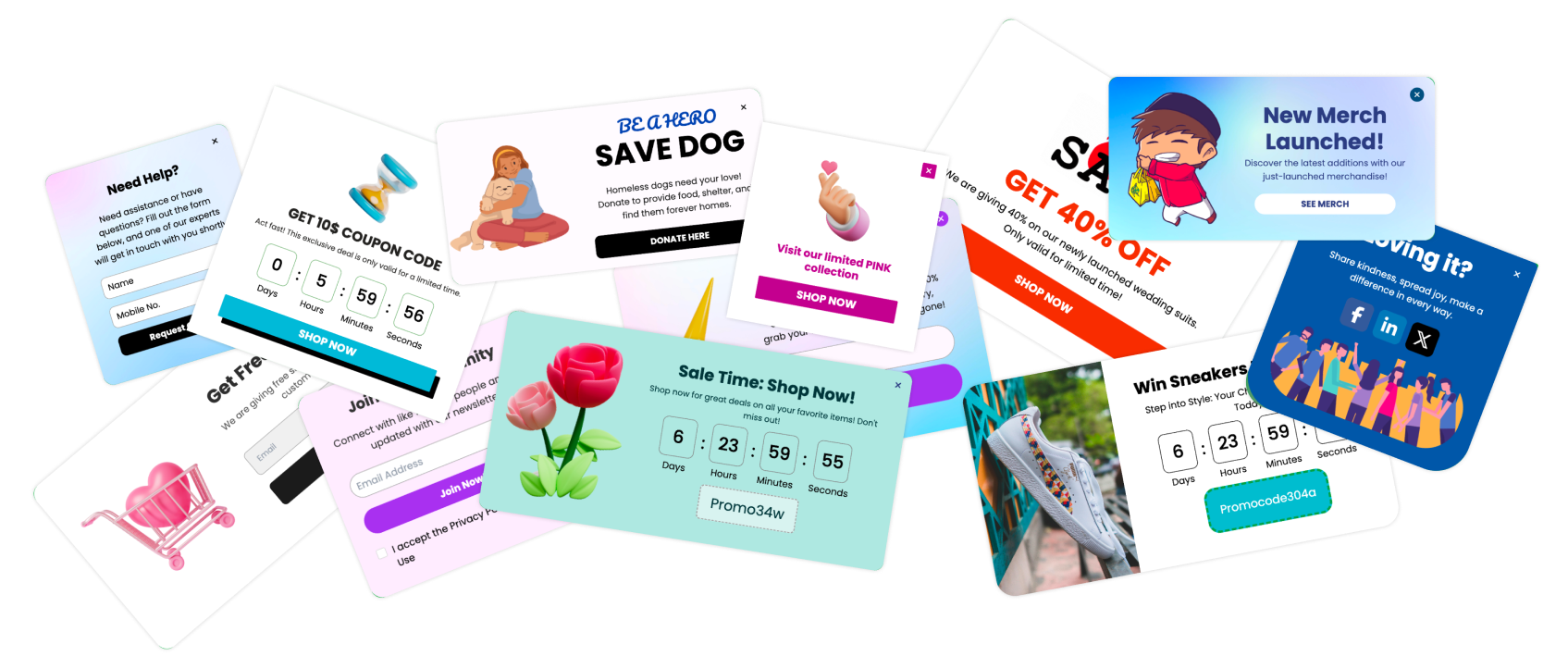Popups, when used strategically, can transform user engagement and significantly boost conversion rates. However, these tools are a double-edged sword in digital marketing; their effectiveness is closely tied to how they are deployed and perceived by users.
Popups are not just tools; they are a form of communication. Misuse them, and you risk silencing your message.
The Role of Popups in User Experience
Popups can either enhance the user journey or disrupt it, depending on their design and integration. A well-timed and designed popup can guide a user to valuable content or offers, while a poorly implemented one can hinder site navigation and annoy users, potentially increasing bounce rates.
The Double-Edged Sword of Popup Use
Balancing the attention-grabbing features of popups with overall user experience is crucial. The key lies in their strategic use — ensuring they serve a purpose without overwhelming the user. This introduction sets the stage to explore common popup mistakes and how to effectively avoid them for better user engagement and conversion optimization.
9 Key Popup Mistakes You Should Avoid
Effective use of popups requires an understanding of common pitfalls and how to navigate them. Below, we'll discuss several critical mistakes often made with popups and provide strategies to avoid them, ensuring your popups contribute positively to user experience and business goals.
1. Immediate Popup Deployment
Why Launching Popups Too Soon Annoys Users
Deploying a popup immediately after a user lands on a page can be jarring and disruptive, often leading to a poor first impression and a high likelihood of popup dismissal. Users need a moment to engage with your content before being interrupted.
Optimal Timing Strategies for Popup Deployment
A better approach is to use time delays or behavioral triggers that allow the user to demonstrate some level of engagement before the popup appears. For instance, setting a popup to display after a user has scrolled through 50% of a page shows that the user is interested in the content, making them more receptive to related offers or messages.
2. Non-Targeted Popups
The Importance of Contextual and Audience Relevance
Generic popups that lack personalization or relevance to the user's current engagement can feel spammy and are often ignored. Tailoring popups based on user behavior or segment data increases relevance and effectiveness.
How to Tailor Popups to User Interests and Behaviors
Utilizing analytics to understand where a user is in the customer journey or integrating with CRM data to personalize messages can significantly enhance the effectiveness of popups. For example, displaying a special discount on items similar to what a user has viewed can capture interest and potentially lead to a conversion.
3. Poor Design Choices
Common Design Flaws That Hinder Popup Effectiveness
Overly complex or visually unappealing popups can detract from their message. Poor design choices, such as hard-to-read fonts or clashing colors, can lead to user frustration and dismissal of the popup.
Best Practices for Clean and Appealing Popup Designs
Keep the design simple, visually appealing, and consistent with the brand aesthetic. Ensure that the popup design is intuitive and includes an obvious way to dismiss it, such as a clear "X" in the corner. Using eye-catching yet pleasant color schemes and readable fonts can also enhance the user's engagement with the popup content.
4. Neglecting Mobile Users
Challenges and Solutions for Mobile-Responsive Popups
Many popups are designed with desktop users in mind, overlooking the mobile experience. This oversight can lead to poorly displayed popups on smaller screens, harming the user experience and effectiveness.
Importance of Adapting Popups for Different Screen Sizes
Ensure that all popups are mobile-responsive, meaning they adjust seamlessly to fit different screen sizes. Tools and platforms that create popups should automatically offer responsive design options, making it easier to engage mobile users effectively.
5. Overusing Popups
How Excessive Popups Can Lead to User Annoyance and Site Abandonment
Frequent interruptions by multiple popups can overwhelm and frustrate users, leading to a negative perception of your website and increased chances of abandonment. It's crucial to find a balance that captures user attention without becoming a nuisance.
Finding the Right Frequency for Popup Messages Without Overwhelming Visitors
Limiting popup frequency or using cookies to ensure that returning visitors are not bombarded by the same popup every visit can help maintain a positive user experience. Consider implementing a strategy where popups vary depending on the depth of the user’s interaction with your site, ensuring that they are spaced out over time and contextually relevant.
6. Weak or Unclear Calls-to-Action
The Critical Role of a Strong CTA in Popup Design
A clear and compelling call-to-action (CTA) is essential for converting popup engagements into desired actions. Vague or non-specific CTAs can lead to user confusion and missed opportunities for conversions.
Techniques for Crafting Compelling and Clear CTAs
Ensure your CTA is specific, using action-oriented language that motivates immediate response. For example, instead of a generic "Click here," use "Get your free ebook now!" which clearly communicates what the user will receive. Placement is also crucial; make sure the CTA stands out visually within the popup’s design.
7. Failure to Offer Real Value
Ensuring Popups Offer Enough Incentive for User Action
Popups should provide a clear benefit to the user, whether it's a discount, exclusive content, or access to additional resources. Without a compelling incentive, users are likely to dismiss the popup without engaging further.
Examples of Effective Incentives That Increase Conversion Rates
Discount codes, free trials, and free downloads are all effective incentives that can be offered through popups. These incentives should be closely aligned with the interests of the target audience and provide immediate value.
8. Complicated Closure Mechanisms
Ensuring Easy Dismissal to Enhance User Experience
Popups that are difficult to close can cause significant frustration and negatively impact the user's perception of your brand. It's essential that users can easily dismiss popups without struggling to find the exit button.
The Impact of User Frustration on Engagement Rates
Ease of dismissal not only respects the user's choice but also enhances their overall experience on your site. Providing a straightforward way to close popups can lead to longer site engagement and a greater likelihood of returning visitors.
9. Ineffective Copywriting
The Role of Concise, Persuasive Text in Popup Effectiveness
The text within your popup needs to be concise and to the point, delivering a clear message quickly to grab the user’s attention. Overly wordy or unclear popup copy can lead to user disinterest and higher dismissal rates.
Tips for Writing Impactful and Engaging Popup Content
Focus on key benefits and unique selling propositions that resonate with the target audience. Use engaging, active language that encourages interaction, and keep the message brief but informative.
Best Practices for Popup Design and Deployment
Audience Segmentation for Precision Targeting
Utilizing detailed audience data is key in crafting popups that speak directly to the interests and needs of different user segments. By segmenting your audience based on demographics, browsing behavior, or purchase history, you can create more relevant and effective popups.
Conversion-Focused Design Strategies
An effective popup design should prioritize clarity and encourage action. This includes using a clear visual hierarchy where the most important elements (like CTAs and key messages) stand out. Employ principles of color psychology and strategic placement of visual elements to guide the user’s eye and make the interaction as intuitive as possible.
Effective Use of Exit-Intent Technology
Exit-intent popups are designed to detect when a user is about to leave your site and present them with a compelling message to encourage them to stay or act before they go. Best practices include offering something of undeniable value or a reminder of what they’ll miss if they don’t subscribe or engage with your site.
Ensuring Compliance and Respect for User Privacy
With the increasing emphasis on digital privacy, it’s critical that your popups comply with laws like GDPR. This means providing clear information about data collection, obtaining consent where necessary, and ensuring that closing mechanisms are straightforward and accessible.
Advanced Popup Techniques
Integrating Popups with Broader Marketing Campaigns
For maximum effectiveness, coordinate your popup strategy with other marketing efforts, such as email campaigns or social media. For instance, a popup that collects email addresses can feed directly into a nurturing campaign, creating a seamless user experience that enhances both engagement and conversion rates.
Leveraging Advanced Triggering and Personalization
Advanced triggering options allow popups to appear based on specific user actions or points in their journey, making them more relevant and less intrusive. Personalization techniques can include dynamic content that changes based on the time of day, user location, or their activity on your site, enhancing the perceived value and relevance of the offers or messages presented.
Frequently Asked Questions
How can I determine the best timing for my popups?
The optimal timing for displaying a popup varies depending on your website’s content and the visitor’s behavior. Generally, it's best to allow sufficient time for a user to engage with your content before interrupting their experience. Analyzing user interaction data through tools like Google Analytics can help identify the ideal moment to introduce a popup.
What are the top strategies to ensure my popups are not intrusive?
To minimize intrusiveness, use popups sparingly and strategically. Ensure they are relevant to the user’s current activity and offer significant value. Implementing exit-intent popups, which only appear when a user is about to leave your site, can also reduce perceived intrusiveness, as they target users who are already disengaging.
Can popups actually improve my website’s performance metrics?
Yes, when used correctly, popups can significantly enhance performance metrics such as conversion rates, bounce rates, and average session duration. They are effective tools for converting visitors into leads and customers, especially when they are well-designed and well-timed.
What are some successful real-world examples of popups done right?
Many brands have successfully used popups to boost subscriber lists, increase sales, and improve user engagement. For example, a well-known ecommerce site used a time-limited discount offer via a popup to increase immediate purchases. Another example is a content website that used a signup popup for a free webinar, which significantly increased their subscription rates.
Conclusion
Summing Up Common Popup Mistakes and Their Solutions
Understanding and avoiding common popup mistakes is crucial for any marketer aiming to use this powerful tool effectively. By focusing on strategic deployment, targeted content, and user-friendly design, you can maximize the effectiveness of your popups without alienating your audience.
Encouragement to Continuously Optimize and Innovate
The digital landscape is always evolving, and so are user expectations. Regularly reviewing and refining your popup strategies is essential to stay relevant and effective. Continuously testing different approaches and adapting based on performance data will help ensure your popups remain a valuable asset in your marketing toolkit.




